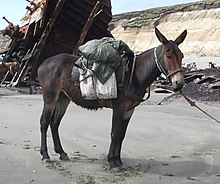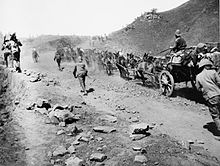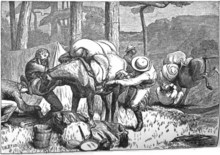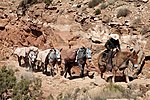How Do You Make A Mule Animal
| Mule | |
|---|---|
 | |
| Conservation status | |
| Domesticated | |
| Scientific classification | |
| Kingdom: | Animalia |
| Phylum: | Chordata |
| Class: | Mammalia |
| Gild: | Perissodactyla |
| Family: | Equidae |
| Tribe: | Equini |
| Genus: | Equus |
| Species: | Eastward. africanus asinus♂ × E. ferus caballus♀ |
| Synonyms | |
| Equus mulus | |

A mule is the offspring of a male donkey (jack) and a female horse (mare).[1] [2] Horses and donkeys are different species, with different numbers of chromosomes. Of the two first-generation hybrids betwixt these two species, a mule is easier to obtain than a hinny, which is the offspring of a female person donkey (jenny) and a male equus caballus (stallion).
The size of a mule and piece of work to which it is put depend largely on the breeding of the mule's mother (dam). Mules can exist lightweight, medium weight, or when produced from typhoon mares, of moderately heavy weight.[3] : 85–87 Mules are more patient, hardy, and long-lived than horses, and are described as less obstinate and more intelligent than donkeys.[4] : 5
Biological science [edit]

The mule is valued considering, while it has the size and ground-covering power of its dam, information technology is stronger than a horse of like size and inherits the endurance and disposition of the donkey sire, tending to require less feed than a equus caballus of like size. Mules also tend to be more independent than most domesticated equines other than its parental species, the donkey.
The median weight range for a mule is between about 370 and 460 kg (820 and 1,000 lb).[5] While a few mules can bear live weight up to 160 kg (353 lb), the superiority of the mule becomes apparent in their additional endurance.[vi]
In general, a mule tin can be packed with expressionless weight up to 20% of its torso weight, or effectually 90 kg (198 lb).[half dozen] Although it depends on the individual animate being, mules trained by the Army of Islamic republic of pakistan are reported to be able to carry up to 72 kg (159 lb) and walk 26 km (16.2 mi) without resting.[7] The average equine in general tin acquit up to roughly 30% of its trunk weight in live weight, such equally a passenger.[8]
A female mule that has estrus cycles, and which could thus in theory carry a fetus, is called a "molly" or "Molly mule", though the term is sometimes used to refer to female mules in full general. Pregnancy is rare, but tin can occasionally occur naturally, as well as through embryo transfer. A male mule is properly called a "horse mule", though oft called a "john mule", which is the correct term for a gelded mule. A young male mule is called a "mule colt", and a young female is called a "mule filly".[nine]
Characteristics [edit]

With its short, thick head, long ears, thin limbs, small-scale, narrow hooves, and short mane, the mule shares characteristics of a donkey. In height and body, shape of neck and rump, uniformity of coat, and teeth, it appears horse-like.[ten] The mule occurs in all sizes, shapes, and conformations. Some mules resemble huge draft horses, sturdy Quarter Horses, fine-boned racing horses, shaggy ponies, and more.
The mule is an example of hybrid vigor.[eleven] Charles Darwin wrote: "The mule always appears to me a most surprising animal. That a hybrid should possess more reason, memory, obstinacy, social affection, powers of muscular endurance, and length of life, than either of its parents, seems to indicate that art has here outdone nature."[12]
The mule inherits from its sire the traits of intelligence, sure-footedness, toughness, endurance, disposition, and natural cautiousness. From its dam information technology inherits speed, conformation, and agility.[13] : 5–6, 8 Mules are reputed to showroom a college cognitive intelligence than their parent species, but robust scientific evidence to back up these claims is lacking. Preliminary data exist from at least two evidence-based studies, only they rely on a limited set of specialized cognitive tests and a small number of subjects.[fourteen] [xv] Mules are more often than not taller at the shoulder than donkeys and have better endurance than horses, although a lower top speed.[16] [fourteen]
Handlers of working animals more often than not notice mules preferable to horses; mules prove more patience nether the pressure of heavy weights, and their skin is harder and less sensitive than that of horses, rendering them more capable of resisting sun and pelting.[ten] Their hooves are harder than horses', and they show a natural resistance to disease and insects. Many North American farmers with clay soil found mules superior as plow animals.
Color and size variety [edit]

Mules exist in a multifariousness of colors and sizes; these mules had a draft mare for a mother.

Mules occur in a variety of configurations, sizes, and colors. Minis counterbalance under 200 lb (91 kg), and other types range up to and over 1,000 lb (454 kg). The coats of mules accept the same varieties as those of horses. Common colors are sorrel, bay, black, and grey. Less common are white, roan, palomino, dun, and buckskin. Least common are paint or tobiano patterns. Mules from Appaloosa mares produce wildly colored mules, much like their Appaloosa equus caballus relatives, but with even more wildly skewed colors. The Appaloosa color is produced by a complex of genes known as the leopard complex. Mares homozygous for this gene complex bred to whatsoever colour ass will produce a spotted mule.
Distribution and utilise [edit]
Mules historically were used by armies to transport supplies, occasionally every bit mobile firing platforms for smaller cannons, and to pull heavier field guns with wheels over mountainous trails such as in Afghanistan during the Second Anglo-Afghan State of war.[17]
The Nutrient and Agriculture System of the United Nations reports that China was the top marketplace for mules in 2003, closely followed by United mexican states and many Fundamental and South American nations.
Fertility [edit]
Mules and hinnies accept 63 chromosomes, a mixture of the equus caballus's 64 and the donkey'southward 62. The unlike structure and number usually prevents the chromosomes from pairing up properly and creating successful embryos, rendering near mules infertile.
A few mare mules take produced offspring when mated with a purebred horse or donkey.[18] [xix] Herodotus gives an account of such an issue equally an ill omen of Xerxes' invasion of Greece in 480 BC: "There happened too a portent of another kind while he was withal at Sardis—a mule brought forth young and gave birth to a mule" (Herodotus The Histories 7:57), and a mule's giving birth was a oft recorded portent in antiquity, although scientific writers also doubted whether it was really possible (see e.g. Aristotle, Historia animalium, vi.24; Varro, De re rustica, two.ane.28).
Every bit of October 2002, but sixty cases of mules birthing foals had been documented since 1527.[19] In China in 1981, a mare mule produced a filly.[20] In Morocco in early on 2002 and Colorado in 2007, mare mules produced colts.[nineteen] [21] [22] Claret and hair samples from the Colorado birth verified that the mother was indeed a mule and the foal was indeed her offspring.[22]
A 1939 article in the Journal of Heredity describes two offspring of a fertile mare mule named "Quondam Bec", which was endemic at the time by Texas A&M Academy in the late 1920s. 1 of the foals was a female, sired by a jack. Dissimilar her mother, she was sterile. The other, sired by a five-gaited Saddlebred stallion, exhibited no characteristics of any donkey. That horse, a stallion, was bred to several mares, which gave birth to live foals that showed no characteristics of the ass.[23] In a more than recent instance, a group from the Federal University of Minas Gerais in 1995 described a female mule that was significant for a seventh time, having previously produced ii donkey sires, two foals with the typical 63 chromosomes of mules, and several equus caballus stallions that had produced four foals. The three of the latter available for testing each bore 64 equus caballus-like chromosomes. These foals phenotypically resembled horses, though they diameter markings absent from the sire's known lineages, and i had ears noticeably longer than those typical of her sire's breed. The elder two horse-like foals had proved fertile at the fourth dimension of publication, with their progeny being typical of horses.[24]
History [edit]

The mule is "the near common and oldest known manmade hybrid."[25] [26] Information technology was likely invented in aboriginal times in what is now Turkey. They were common in Egypt past 3000 BCE.[25] Homer noted their arrival in Asia Minor in the Iliad in 800 BCE. Mules are mentioned in the Bible (Samuel two:18:9, Kings ane:xviii:five, Zacharia xiv:15, Psalms 32:9). Christopher Columbus brought mules to the New Earth.[26] George Washington is known equally the male parent of the American mule due to his success in producing 57 mules at his home at Mount Vernon. At the time, mules were not common in the U.s., but Washington understood their value, every bit they were "more docile than donkeys and inexpensive to maintain."[27] In the 19th century, they were used in diverse capacities as draft animals - on farms, particularly where dirt made the soil slippery and sticky; pulling canal boats; and famously for pulling, often in teams of 20 or more animals, wagonloads of borax out of Death Valley, California from 1883 to 1889. The wagons were amongst the largest ever pulled by draft animals, designed to carry 10 short tons (nine metric tons) of borax ore at a time.[28]
Modernistic usage [edit]

In the second half of the 20th century, widespread usage of mules declined in industrialized countries. The use of mules for farming and transportation of agronomical products largely gave way to steam-, and then gasoline-powered, tractors and trucks.
Mules are still used extensively to ship cargo in rugged, roadless regions, such every bit the large wilderness areas of California'due south Sierra Nevada mountains or the Pasayten Wilderness of northern Washington. Commercial pack mules are used recreationally, such as to supply mountaineering base camps, and as well to supply trail-building and maintenance crews, and backcountry footbridge-building crews.[29] Equally of July 2014, at to the lowest degree sixteen commercial mule pack stations are in business organization in the Sierra Nevada.[xxx] The Angeles chapter of the Sierra Club has a mule pack department that organizes hiking trips with supplies carried by mules.[31]
During the Soviet–Afghan War, mules were used to carry weapons and supplies over Afghanistan'due south rugged terrain to the mujahideen.[32]
About 3.5 one thousand thousand donkeys and mules are slaughtered each yr for meat worldwide.[33]
Mule trains take been part of working portions of transportation links as recently as 2005 by the World Nutrient Programme.[34]
Trains [edit]

A British mule train during the Second Anglo-Boer War, South Africa

A "mule railroad train" is a connected or unconnected line of pack mules, ordinarily conveying cargo. Considering of the mule's ability to carry at least every bit much as a horse, its trait of being sure-footed along with tolerance of poorer, coarser foods and abilities to tolerate arid terrains, mule trains were common caravan organized means of animal-powered majority transport back into preclassical times. In many climate and circumstantial instances, an equivalent cord of pack horses would have to carry more fodder and sacks of high-energy grains such every bit oats, so could carry less cargo. In modern times, strings of certain-footed mules accept been used to carry riders in dangerous but breathtaking backcountry terrain such as excursions into canyons.
Pack trains were instrumental in opening up the American Westward, as they could bear upward to 250 lb (110 kg), survive on rough fodder,[a] did not require feed, and could operate in the barren, higher elevations of the Rockies, serving every bit the main cargo ways to the westward from Missouri during the heyday of the North American fur merchandise. Their use antedated the move west into the Rockies as colonial Americans sent out the commencement fur trappers and explorers past the Appalachians, who were then followed west by loftier-hazard-taking settlers by the 1750s (such as Daniel Boone), who led an increasing flood of emigrants who began pushing west over into southern New York, and through the gaps of the Allegheny into the Ohio Land (the lands of western Province of Virginia and the Province of Pennsylvania), into Tennessee and Kentucky before and especially after the American Revolution.
Gallery [edit]
-

-

-

-

SS Mexican unloading US Army mules in Naples, Italy, in September, 1944
-

Clone [edit]
In 2003, researchers at University of Idaho and Utah State University produced the kickoff mule clone every bit part of Projection Idaho.[35] The research team included Gordon Woods, professor of animal and veterinarian science at the University of Idaho; Kenneth L. White, Utah Land University professor of animal science; and Dirk Vanderwall, University of Idaho assistant professor of animal and veterinary scientific discipline. The infant mule, Idaho Gem, was born May 4. It was the first clone of a hybrid brute. Veterinarian examinations of the foal and its surrogate mother showed them to exist in good wellness shortly after birth. The foal's DNA comes from a fetal cell culture first established in 1998 at the University of Idaho.
Come across also [edit]
- African wild donkey
- Forty acres and a mule
- Headless Mule, a cursed woman in Brazilian folklore
- Jennet, a small Spanish equus caballus
- Kiang, the Tibetan ass
- List of genetic hybrids
- No Mule's Fool
- Onager, the Asiatic wild ass
- Zebroid
Notes [edit]
- ^ Crude forage means mules, donkeys, and other asses, like many wild ungulates such every bit various deer species, can tolerate eating small shrubs, lichens, and some branch-laden tree foliages and obtaining diet from such. In contrast, the digestive organisation of horses and to a lesser extent cattle are more dependent upon grasses, and evolved in climates where grasslands involved stands of grains and their high-energy seed-heads.
Citations [edit]
- ^ "Mule Mean solar day: A Local Legacy". americaslibrary.gov. Library of Congress. 18 December 2013. Retrieved 22 September 2020.
- ^ "What is a mule?". The Donkey Sanctuary.
- ^ Ensminger, 1000. E. (1990). Horses and Horsemanship: Animal Agronomics Series (Sixth ed.). Danville, IL: Interstate. ISBN0-8134-2883-i.
- ^ Jackson, Louise A (2004). The Mule Men: A History of Stock Packing in the Sierra Nevada. Missoula, MT: Mountain Press. ISBN0-87842-499-7.
- ^ "Mule". The Encyclopædia Britannica: A Dictionary of Arts, Sciences, and General. Vol. XVII. Henry K. Allen and Company. 1888. p. 15.
- ^ a b "Hunter'south Specialties: More With Wayne Carlton On Elk Hunting". hunterspec.com. Hunter'southward Specialties. 2009. Archived from the original on 8 October 2010. Retrieved 16 July 2014.
- ^ Khan, Aamer Ahmed (19 October 2005). "Beasts ease burden of quake victims". BBC. Retrieved six Apr 2010.
- ^ American Endurance Ride Conference (Nov 2003). "Affiliate 3, Section Four: Size". Endurance Passenger's Handbook. AERC. Archived from the original on 15 May 2008. Retrieved seven Baronial 2008.
- ^ "Longear Lingo". lovelongears.com. American Donkey and Mule Society. 22 May 2013. Retrieved xvi July 2014.
- ^ a b One or more of the preceding sentences incorporates text from a publication now in the public domain:Chisholm, Hugh, ed. (1911). "Mule". Encyclopædia Britannica. Vol. 18 (11th ed.). Cambridge University Press. pp. 959–960.
- ^ Chen, Z. Jeffrey; Birchler, James A., eds. (2013). Polyploid and Hybrid Genomics. John Wiley & Sons. ISBN978-0-470-96037-0 . Retrieved 16 July 2014.
- ^ Darwin, Charles (1879). What Mr. Darwin Saw in His Voyage Circular the World in the Ship 'Beagle' . New York: Harper & Bros. pp. 33–34. Retrieved 16 July 2014.
- ^ Hauer, John, ed. (2014). The Natural Superiority of Mules. Skyhorse. ISBN978-one-62636-166-nine . Retrieved xvi July 2014.
- ^ a b Proops, Leanne; Faith Burden; Britta Osthaus (18 July 2008). "Mule knowledge: a case of hybrid vigor?". Animal Noesis. 12 (1): 75–84. doi:10.1007/s10071-008-0172-i. PMID 18636282. S2CID 27962537.
- ^ Giebel; et al. (1958). "Visuelles Lernvermögen bei Einhufern". Zoologische Jahrbücher. Physiologie. 67: 487–520.
- ^ "Which is taller, a Mule or a Horse?". Purelyfacts.
- ^ Explanation of Mule Battery WDL11495.png Library of Congress
- ^ Savory, Theodore H (1970). "The Mule". Scientific American. 223 (vi): 102–109. Bibcode:1970SciAm.223f.102S. doi:10.1038/scientificamerican1270-102.
- ^ a b c Kay, Katty (2 October 2002). "Morocco'southward phenomenon mule". BBC News . Retrieved 5 Feb 2009.
- ^ Rong, Ruizhang; Cai, Huedi; Yang, Xiuqin; Wei, Jun (October 1985). "Fertile mule in China and her unusual foal". Periodical of the Royal Society of Medicine. 78 (10): 821–25. doi:10.1177/014107688507801006. PMC1289946. PMID 4045884.
- ^ "Befuddling Birth: The Case of the Mule's Foal". National Public Radio. 26 July 2007. Retrieved v February 2009.
- ^ a b Lofholm, Nancy (19 September 2007). "Mule'due south foal fools genetics with 'impossible' nativity". Denver Post.
- ^ Anderson, W. S. (1939). "Fertile Mare Mules". Journal of Heredity. thirty (12): 549–551. doi:ten.1093/oxfordjournals.jhered.a104657.
- ^ Henry, M.; Gastal, E.Fifty.; Pinheiro, L.E.L.; Guimarmes, S.Due east.F. (1995). "Mating Pattern and Chromosome Assay of a Mule and Her Offspring". Biological science of Reproduction. 52 (Equine Reproduction VI – Monograph Series one): 273–279. doi:10.1093/biolreprod/52.monograph_series1.273.
- ^ a b "History of the Mule". American Mule Museum . Retrieved xv February 2020.
- ^ a b "Mules, mankind share a mutual history in modern world". The Daily Herald . Retrieved fifteen February 2020.
- ^ Chernow, Ron (2010). Washington: A Life. New York: The Penguin Printing. pp. 483–484. ISBN978-1-59420-266-vii. OCLC 535490473.
- ^ "Mules hauling a 22,000lb boiler". Texas State Library and Archives Commission.
- ^ Jackson, Louise A (2004). The Mule Men: A History of Stock Packing in the Sierra Nevada. Missoula, MT: Mountain Press. ISBN 0-87842-499-7.
- ^ "Members of the Eastern Sierra Packers". easternsierrapackers.com. Eastern Sierra Packers. 18 January 2009. Retrieved 16 July 2014.
- ^ "Mule Pack Section, Angeles Chapter, Sierra Order". angeles.sierraclub.org. Angeles Chapter Sierra Club. eighteen April 2014. Retrieved 16 July 2014.
- ^ Bearden, Milt (2003) The Chief Enemy, The Inside story of the CIA'due south Final showdown with the KGB. Presidio Press. ISBN 0345472500
- ^ "FAOSTAT". www.fao.org . Retrieved 25 October 2019.
- ^ "Mule railroad train provides lifeline for remote convulse survivors". www.wfp.org. World Nutrient Program. Archived from the original on 8 December 2015. Retrieved iv September 2015.
- ^ "Projection Idaho". University of Idaho. 29 May 2003. Archived from the original on ix August 2009. Retrieved 16 July 2014.
Farther reading [edit]
- Arnold, Watson C. (2008). "The Mule: The Worker that "Can't Go No Respect"". Southwestern Historical Quarterly. 112: 34–50. doi:10.1353/swh.2008.0002. S2CID 143167549.
- Buchholz, Katharina (16 Baronial 2013). "Colorado miracle mule foal lived short life, but was well-loved". Denver Post . Retrieved 16 July 2014.
- Ellenberg, George B. (2007). Mule South to Tractor Southward: Mules, Machines, and the Transformation of the Cotton South. University of Alabama Printing. ISBN9780817357726.
- Chandley, A. C.; Clarke, C. A. (1985). "Cum mula peperit". Journal of the Purple Society of Medicine. 78 (ten): 800–801. doi:10.1177/014107688507801003. PMC1289943. PMID 4045882.
- Loftus, Nib (August 2003). "It's a Mule: UI produces get-go equine clone". Hither Nosotros Have Idaho: The Academy of Idaho Magazine. Academy of Idaho: 12–xv. Retrieved 16 July 2014.
- Lukach, Mark (11 September 2013). "In that location Is a Man Wandering Around California With iii Mules". The Atlantic. Atlantic Monthly Group. Retrieved 16 July 2014.
- Rong, R.; Chandley, A. C.; Song, J.; McBeath, South.; Tan, P. P.; Bai, Q.; Speed, R. Grand. (1988). "A fertile mule and hinny in Mainland china". Cytogenetic and Genome Research. 47 (iii): 134–9. doi:x.1159/000132531. PMID 3378453.
- Williams, John O; Speelman, Sanford R (1948). "Mule production". Farmers' Message. U.S. Department of Agriculture. 1341 . Retrieved 16 July 2014. Hosted by the UNT Digital Library. Originally published by the U.S. Government Printing Office.
External links [edit]
| | Look upward mule in Wiktionary, the free lexicon. |
- American Ass and Mule Society
- American Mule Clan
- British Mule Order Archived 25 Nov 2017 at the Wayback Auto
- Canadian Ass & Mule Clan
Source: https://en.wikipedia.org/wiki/Mule
Posted by: harrisblapeneve.blogspot.com

0 Response to "How Do You Make A Mule Animal"
Post a Comment